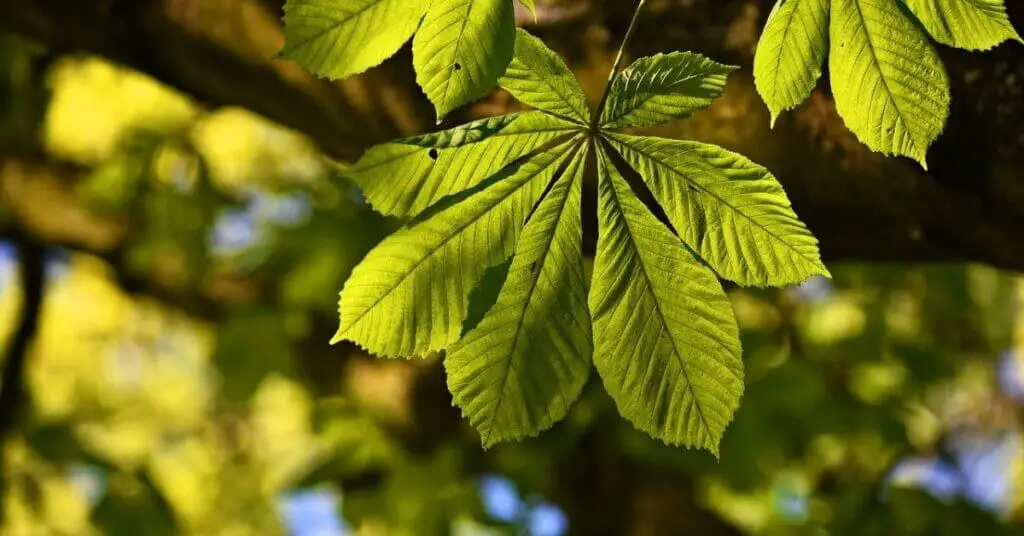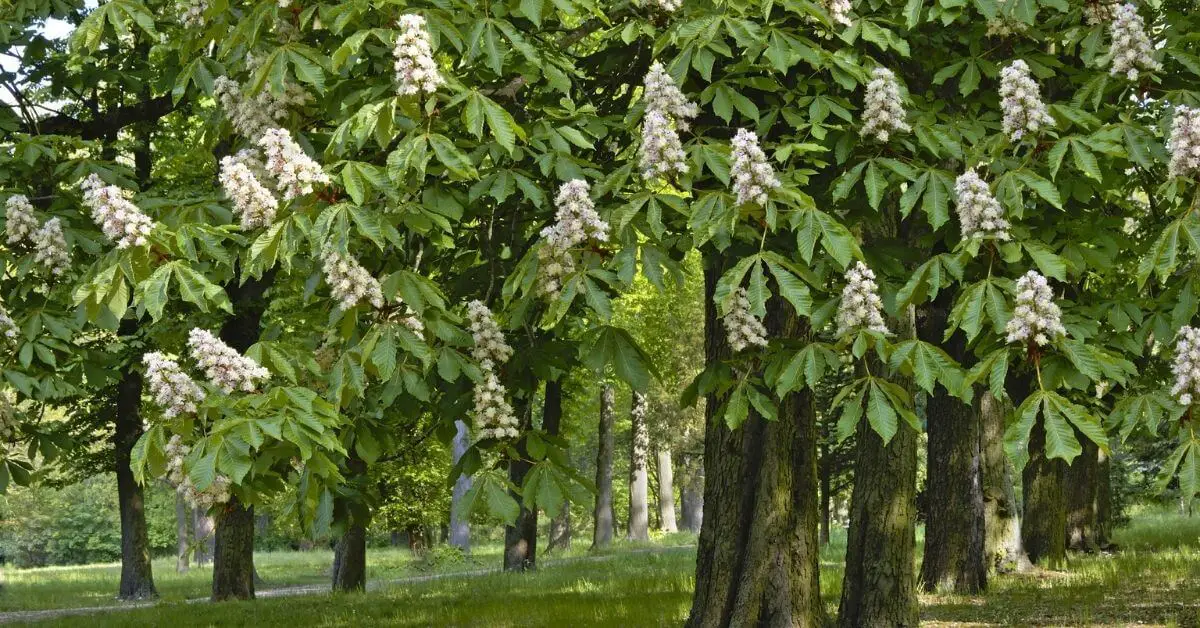Introduction
All chestnut woods are strong, durable, and soft. These woods are easy to work with all types of tools.
The chestnut is a name for eight or nine species of deciduous trees in the genus Castanea. They are native to the Northern Hemisphere. Almost all species of chestnut produce nuts. Which humans, squirrels, and small birds take as food.
The four famous species are American, European, Chinese, and Japanese chestnuts. Their physical properties (color, luster, texture, macro-structure, odor, moisture, shrinkage, internal stresses, swelling, cracking, warping, density, etc.) are different from each other. It is used based on its properties.
| # | Chestnut wood |
| Scientific Name | Castanea |
| Tree Height | 50 to 75 feet |
| Workability | Overall good |
| Wood Grain Pattern | Grain is straight to spiral or interlocked |
| Wood Color | Pale white to light or dark brown |
| Durability | Very durable |
| Rot Resistance | It is good rot resistant. |
| Type | Hardwood |
| Uses | Home construction, cabinetry, furniture, utility poles, railroad ties, flooring, and musical instruments |
Uses of Chestnut wood
Flooring
Hardwood wood is considered better for flooring. Because hardwood wood is less prone to scratches and dents than softwood. Chestnut is a hardwood species. But not all chestnuts are suitable for flooring.
American Chestnut, whose Average Dried Weight is 30 lbs/ft3 (480 kg/m3) and Janka Hardness is 540 lbf (2,400 N) can be a good choice for flooring.
But any type of wood floor needs the care to prevent scratches and dents. You can use furniture leg pads and keep the pet’s nails short. It’s an efficient way to save your floor.
Furniture
To make great furniture, wood must have shock resistance, durability, and natural appearance properties.
American chestnut is naturally rot-resistant, durable, and straight-grained. So it is suitable wood for making rustic furniture. It can also be easily stained as you like.
For American chestnuts, Oak is considered an alternative. Because American chestnuts have oak-like qualities.
Shingles
To make quality shingles, the wood must be resistant to water, ultraviolet rays, insects, and moss.
Horse and sweet chestnut have poor decay resistance and are rated as non-durable to perishable.
So once again, American chestnut is a great option for making durable shingles. In earlier times the bark of American chestnut had been used to make shingles. Even today it can be seen in many rural areas.
Musical instruments
A musical instrument maker chooses the wood very carefully. Because many challenges have to be faced while making great instruments. As wood should have better bending, gluing, and appearance properties.
In this case, Sweet and Horse Chestnut are suitable wood species to make musical instruments. However, it is not as famous as mahogany and Sapele but it is also popular.
Chestnut Wood Workability
Chestnut Wood’s workability is much better than many other hardwoods. The reason for this is low hardness and straight grain. Sweet Chestnut is a better option for carving, which can be carved easily.
American chestnuts can be a bit difficult to carve due to their irregular grain patterns. But overall workability is excellent.
Sweet Chestnut, American chestnut Out Most species of chestnut split easily. So be careful while working on this species. To prevent the split, do pre-drilling before applying the nail and screw.
Chestnut Wood Hardness
Generally, we know that the density of hardwood species is high and that hardwood woods are stronger while softwoods are weak and light. But it is not 100% correct.
Chestnut is a hardwood type of wood. But its Janka hardness value is less than many softwoods. Therefore, only a few chestnut species are considered suitable for flooring and furniture.
| # | Janka Hardness |
| Horse chestnut | 820 lbf (3,630 N) |
| Sweet Chestnut | 680 lbf (3,010 N) |
| American Chestnut | 540 lbf (2,400 N) |
Chestnut wood Pros and Cons

Pros
Appearance: Chestnut has a light or dark brown natural color with a rustic appearance. A great choice for outdoor and indoor, cottages, farms, and furniture.
The color of some species darkens over time (darkening and reddish hue). This happens due to exposure to UV rays and oxygen.
Cost-effective: chestnut wood justifies its own price. It is a cost-effective wood species as compared to other hardwoods. American chestnuts cost around $15-20 per square foot.
However, the price of wood depends on many factors, such as the grade of the wood, and the place to buy it (wood is cheaper in the native place).
Versatile: Most species of chestnut are versatile and can be used for outdoor and indoor uses such as posts, fencing, outdoor furniture, and indoor furniture
Not Harmful: Although no adverse health effects have specifically been reported for American Chestnut (Castanea dentata), some other species have been reported to cause skin irritation.
But you need to be careful when working with any type of wood.
Cons
Difficult to Recognize: There are more than 15 species of chestnut wood. Some are true chestnuts and some are not. Owners often have difficulty recognizing the true Chestnut lumber. So there is a high possibility of fraud with the owners.
To avoid fraud, always buy from a trusted dealer.
Splits Easily: The grain of chestnut is usually straight, and after drying the moisture of the wood, it starts splitting on its own. But this kind of problem may not be seen in all species.
Price: If we compare it with some other hardwood species, chestnut lumber is more expensive. If you buy in bulk, the dealer may give you a discount.
Is Chestnut Good Firewood?
American chestnut may be a better choice for firewood. It will produce 18.0 million BTUs per cord. It produces more heat than alder, and basswood but less heat than cherry, fir, and elm.
Chestnut Tree Identification
Chestnut trees are large deciduous trees. They are medium to fast-growing trees, and their growth rate is about 24 to 36 inches (2 to 3 feet) per year.
A tree can grow to be 60 to 80 feet (18-24 m) tall and 3 to 5 feet in diameter. Chestnut trees prefer sandy, loamy, well-drained, and somewhat acidic soil (pH 4.5-6.5).
Chestnut Flowers
Flowers appear in late spring or early summer or from June to July. They are arranged in long catkins. The flowers are creamy-white that give off a strong, sweet aroma.
Chestnut Bark
Young chestnut trees have smooth, reddish-brown, or gray bark. Vertical fissures develop and create diamond patterns with age. The color variation depends on the species.
Chestnut Leaves

Leaves are ovate or lanceolate-shaped with sharply pointed leaves. It is 6” to10” (15 – 25 cm) long and about 4” (10 cm) wide. It is yellowish-green in the beginning and turns a golden yellow in the fall before the leaves drop.
Chestnut nuts
American, European, Chinese, and Japanese are edible. Horse chestnuts are toxic. Not all species of nuts are edible. The 3-5-year-old tree starts producing nuts and the healthy 10-year-old tree can produce as much as 15-20 lbs/tree.
Types of Chestnut Wood
There are many types of chestnut. Some chestnuts are confusing such as the horse chestnut. It is not a true chestnut but it produces nuts and is very close to true chestnut. Therefore it is also counted in the category of chestnut.
American Chestnut (Castanea dentata)
The American chestnut is a large deciduous tree of the beech family. Because of its great properties, this is the most famous species of chestnut which is used the most. It is native to eastern North America.
American Chestnuts were heavily harvested in the 20th century. During this, many large trees were cut down. So there was a huge decline in the population of this species.
Color Appearance: Its heartwood is light to medium brown in color, which darkens to reddish-brown with age. Whereas sapwood is light white to light brown in color. Due to the presence of insects in wood, the color may become discolored.
Uses: American chestnut is known for its durability and rot resistance properties. Its Janka hardness is not very high (540 lbf (2,400 N)) yet it is widely used for flooring, rustic furniture, and shingles.
Grain/Texture: It has straight to spiral or interlocked grain. With a coarse, uneven texture.
Workability: Great workability, easy to work with both hand and machine tools. Glues, stains, and finishes well.
Sweet Chestnut (Castanea sativa)
Sweet Chestnut is also known as Spanish Chestnut or European Chestnut. It is a species of tree in the family Fagaceae. Sweet chestnut is native to Southern Europe and Asia Minor. The lifespan of a sweet chestnut is very long (about 400 to 450 years).
Color and Appearance: Sweet Chestnut Heartwood is a light to medium brown. With time it turns reddish-brown. While the sapwood is well-defined and is pale white to light brown.
Uses: Sweet chestnut is a hard and great wood species, so it is most commonly used for making furniture and veneer. It can also be easily carved and molded. Therefore, it is also used to make small wooden objects.
Sweet chestnut is widely cultivated for its edible seeds (also called nuts). Its nuts have a good demand in the market.
Grain/ Texture: Sweet Chestnut has straight to spiral or interlocked grain. With a coarse, uneven texture.
Workability: Workability is great. It is easy to work with both hand and machine tools. It splits easily, so be careful while nailing. Pre-drilling would be better for nailing and screwing.
Japanese chestnut (Castanea crenata)
Japanese chestnut is known as Korean chestnut, Korean Castanea, and Japanese chestnut. It is native to Japan and Korea. Japanese chesnut is a small to medium-sized deciduous tree. It grows to 10–15 m tall. Its leaves and tree structure are similar to sweet chestnuts.
Flowers of both sexes are 7–20 cm long, with male flowers in the upper part and female flowers in the lower part. which can be easily recognized.
Uses: The people of Japan are heavy cultivators of sweet, edible nuts.
Chinese chestnut (Castanea mollissima )
Chinese chestnut, also known as Chinese chestnut, is native to China, Taiwan, and Korea. It is a deciduous tree growing to 20 m tall and 10 m wide. Their leaves are 10–22 cm long and 4.5–8 cm broad. The growth rate of their tree is about 12″ to 24″ per year.
Uses: Like other species of chestnut, the Chinese chestnut also produces nuts that are in high demand in the market. Farmers in East Asia, are widely cultivated for nuts production.
Chinese chestnut wood is very durable and resistant to rot. Therefore, it is used for furniture and construction.
Grain/Texture: Straight grain pattern with a uniform texture.
Workability: Overall good; It is easy to work with both hand and machine tools. It splits easily.
Dwarf Chestnut (Castanea pumila)
Dwarf Chestnut is commonly known as the Allegheny chinquapin. American chinquapin is native to the southeastern United States. This main habitat is in dry sandy and rocky areas.
As the name suggests, its tree is a dwarf. Its length is only 2–8 m, which is the smallest tree of all species of Chestnut.
Color/Appearance: Heartwood is yellowish-brown, whereas sapwood is almost white in color.
Uses: Mainly it is used for nuts. Native Americans use their nuts as food. Its nuts squirrels and rabbits use as their main diet. Dwarf Chestnut wood is hard, and durable, used in fences, furniture, fuel, etc.
Grain/Texture: Typically it has a straight and interlocked grain pattern.Workability: Generally, it is easy to work with hand and machine tools, glue, and finishes well.
Horse chestnut (Aesculus hippocastanum)
Horse chestnut is native to Eastern Europe. It is known for its strength, durability, and elastic properties. According to Wikipedia, horse chestnuts are not true chestnuts, but this is producing nuts similar to other species of chestnut.
Color/Appearance: Heartwood is creamy white or yellowish-brown, whereas sapwood is almost white in color.
Uses: It is considered suitable for making racket grips, broom handles, kitchen utensils, boxes, Veneer, furniture, plywood, interior trim, turned objects, and toys.
However, it does not have the properties of rot resistance. Therefore, it is not suitable for outdoor use.
Grain/ Texture: Its grain can be wavy or interlocked. But its texture is fine so that it gives a uniform look to the furniture.
Workability: In general, horse chestnuts can be easily worked with hand tools and machines. But sometimes it can be difficult to work with due to the interlocked grain pattern. But glues and finishes well.
Seguin chestnut (Castanea Seguinii)
Seguin’s chestnut, also called Seguin chestnut, Seguin’s chestnut, or Chinese chinquapin, is native to south-central and southeast China. It is small trees or shrubs, rarely reaching 12 m.
Uses: Nuts are edible and cultivated in the wild and consumed by locals. Its nuts are small, so it is not cultivated commercially.
Conclusion
The American chestnut and other chestnut trees are on the verge of extinction. 100 to 150 years ago, the share of chestnuts in America’s forests was about 25%. At this time this species is going extinct. Some organizations are working hard to maintain nature. In which chestnut planting is being done again on a large scale.


Comments are closed.